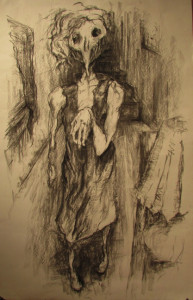Editor’s note: This is the first in a series of essays written by University of Central Missouri students about the work of a graduating art major’s senior show.
By TABITHA NEVINS
Kelsey Helmig was born and raised in Owensville, Missouri, and currently lives in Blue Springs, Missouri. She is working on her Bachelor of Fine Arts in Studio Art: Illustration at the University of Central Missouri.
Helmig is a talented illustrator and painter and has quite the eye for drawing as well. Her work was recently displayed in the Art Center Gallery as part of the Senior Show. Helmig has a distinct hand, and you can see consistent patterns and habits throughout her work. A lot of distinguished artists had to start somewhere, and Helmig had an enlightening experience in her Drawing III class at UCM with professor Chris Lowrance.
Lowrance taught Helmig that it is important to show the history of an object and the history of your piece. This can refer to any lines the artist has drawn that are no longer necessary, but still can be seen, even just a little bit, in the final piece. Some art professors are adamant and direct with instructions to “let your hand be seen in the drawing” or “not to be afraid to show the drawing’s history of how you ended up there.” As Helmig slowly started working bigger, her lines became more important, and she understood what Lowrance meant.
“If I did (some of) these pieces digitally, they would lose some of that essence with the loss of my hand in the piece,” Helmig said.
Helmig prefers ink, charcoal and watercolor. These are all mediums that she feels best convey her ideas visually. “I can almost always add a quick dab of ink or lines of charcoal to a piece of paper,” she said.
However, she does tinker with computer programs. Still, Helmig said there is something more permanent and raw with traditional mediums, unlike digital art where you can sometimes just backspace through a decision.
Sometimes enjoying simple, cute characters and subject matters, Helmig connects with contemporary British Colombian artists Thyrza Segal and Chris McMahon. Segal and McMahon take old paintings they find in thrift stores and paint monsters and aliens.
Helmig is very soulful and passionate and her art tends to depend on where she is emotionally. “I believe that delving into all different concepts and feelings is an important part of an artist growing,” Helmig said. For example, she said she wouldn’t have wanted to draw Leo, her stuffed lion, if she was in a bad mood. Slumped over in a posed, yet relaxed position, you can see the years on every inch of this little lion keepsake. The details in this charcoal piece are impeccable. The mane is wiry and twists and tangles in every direction. Helmig captures the softest of wrinkles on Leo’s body, and the patchy spots are seen on his curved back. A light source is made clear and kept consistent across the paper. One could understand upon seeing this that the artist strongly admired this dear lion.
Helmig’s biggest inspiration is illustrator Stephen Gammell, who is known for his art in the children’s books, “Scary Stories to Tell in the Dark” by Alvin Schwartz. Helmig said Gammell’s illustrations were particularly inspiring to her because of his ability to capture the essence of the settings and the creatures that go bump in the night. When she was younger and growing up, Helmig said she was “obsessed with creepy paranormal things.” She sometimes draws insight and creativity from monsters in nightmares.
“The Lady” is a charcoal drawing that shows a narrow hallway fully decorated with hanging art and a table lamp. A lady is walking toward the viewer. One arm is slightly reaching forward with the wrist limp, leaving the hand hanging like a dead limb. Shoulders are slumped forward while the other arm swings back. Despite the long, draping dress, you can tell this lady is boney underneath with her skinny legs and knobby knees sticking out of the bottom of the dress. The face is the most disturbing of all. With soulless eyes, there are no definite details on her face, making her feel more like a spirit instead of a being.
One of Helmig’s pieces from the Senior Show is titled “The Buffalo.” The black flows effortlessly across the paper on this ink and charcoal piece. Using the whitest paper, she builds a strong color gradient. Three buffalo are presented. The first is head-on facing the viewer and is the darkest of the three. He has the most detail and drips with ink at the bottom. The middle buffalo is seemingly only done with ink, and most impressively it is drawn using mostly negative space. The composition is brought together with the silhouette of one last buffalo in the far right distance and complementary shading in the bottom right corner.
She said her dreams of buffalo came from the Native American history that her father would tell her. Her father taught her to respect nature and animals, and how their Native American ancestors would hunt. This carried into Helmig and her father’s bonding over hunting.
Having her art displayed at the university’s gallery is only the beginning for Helmig, and she is sure to turn her illustration and drawing skills into something that will build a foundation for her entire future.
Tabitha Nevins is pursuing a BFA in interior design at UCM. She wrote this essay as an assignment in Beyond Beauty, a class on art and writing.





Leave a Reply